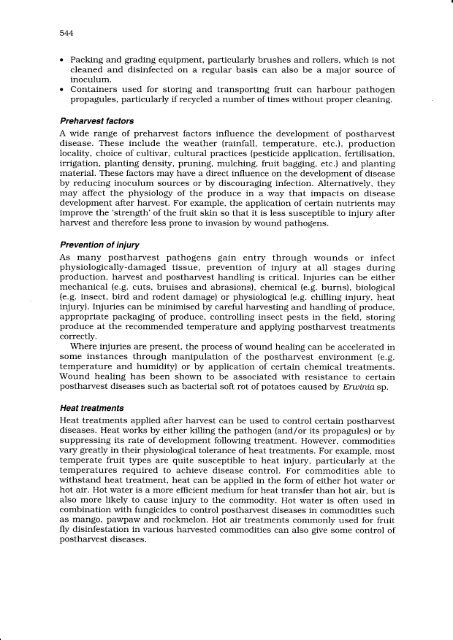POSTHARVEST DISEASES OF FRUIT AND VEGETABLES Lindy ...
POSTHARVEST DISEASES OF FRUIT AND VEGETABLES Lindy ...
POSTHARVEST DISEASES OF FRUIT AND VEGETABLES Lindy ...
You also want an ePaper? Increase the reach of your titles
YUMPU automatically turns print PDFs into web optimized ePapers that Google loves.
544<br />
Packing and grading equipment, particularly brushes and rollers, which is not<br />
cleaned and disinfected on a regular basis can also be a major source of<br />
inoculum.<br />
Containers used for storing and transporting fruit can harbour pathogen<br />
propagules, particularly if recycled a number of times without proper cleaning.<br />
Preharvest tactors<br />
A wide range of preharvest factors influence the development of postharvest<br />
disease. These include the weather (rainfall, temperature, etc.), production<br />
locality, choice of cultivar, cultural practices (pesticide application, fertilisation,<br />
irrigation, planting density, pruning, mulching, fruit bagging, etc.) and planting<br />
material. These factors may have a direct influence on the development of disease<br />
by reducing inoculum sources or by discouraging infection. Alternatively, they<br />
may affect the physiology of the produce in a way that impacts on disease<br />
development after harvest. For example, the application of certain nutrients may<br />
improve the 'strength' of the fruit skin so that it is less susceptible to injury after<br />
harvest and therefore less prone to invasion by wound pathogens.<br />
Prevention of injury<br />
As many postharvest pathogens gain entry through wounds or infect<br />
physiologically-damaged tissue, prevention of injury at all stages during<br />
production, harvest and postharvest handling is critical. Injuries can be either<br />
mechanical (e.g. cuts, bruises and abrasions), chemical (e.g. burns), biological<br />
(e.9. insect, bird and rodent damage) or physiological (e.g. chilling injury, heat<br />
injury). Injuries can be minimised by careful harvesting and handling of produce,<br />
appropriate packaging of produce, controlling insect pests in the field, storing<br />
produce at the recommended temperature and applying postharvest treatments<br />
correctly.<br />
Where injuries are present, the process of wound healing can be accelerated in<br />
some instances through manipulation of the postharvest environment (e.g.<br />
temperature and humidity) or by application of certain chemical treatments.<br />
Wound healing has been shown to be associated with resistance to certain<br />
postharvest diseases such as bacterial soft rot of potatoes caused by En-uinia sp.<br />
Heat treatments<br />
Heat treatments applied after harvest can be used to control certain postharvest<br />
diseases. Heat works by either killing the pathogen (and/or its propagules) or by<br />
suppressing its rate of development following treatment. However, commodities<br />
vary greatly in their physiological tolerance of heat treatments. For example, most<br />
temperate fruit types are quite susceptible to heat injury, particularly at the<br />
temperatures required to achieve disease control. For commodities able to<br />
withstand heat treatment, heat can be applied in the form of either hot water or<br />
hot air. Hot water is a more efficient medium for heat transfer than hot air, but is<br />
also more likely to cause injury to the commodity. Hot water is often used in<br />
combination with fungicides to control postharvest diseases in commodities such<br />
as mango, pawpaw and rockmelon. Hot air treatments commonly used for fruit<br />
fly disinfestation in various harvested commodities can also give some control of<br />
postharvest diseases.






![[Compatibility Mode].pdf](https://img.yumpu.com/27318716/1/190x135/compatibility-modepdf.jpg?quality=85)










